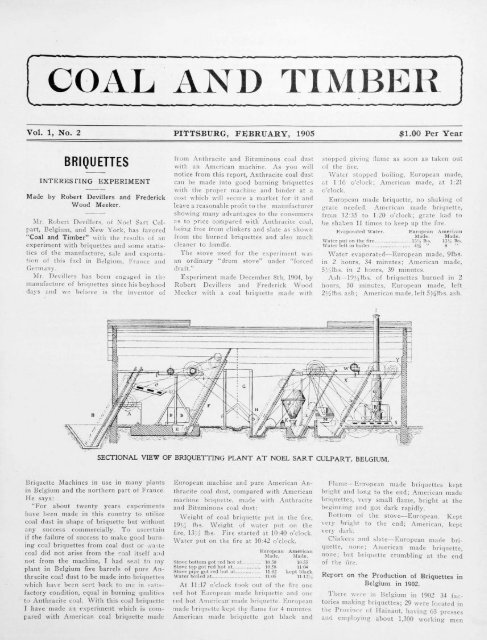You also want an ePaper? Increase the reach of your titles
YUMPU automatically turns print PDFs into web optimized ePapers that Google loves.
(~i<br />
I<br />
COAL AND TIMBER<br />
• ><br />
Vol. 1, No. 2 PITTSBURG, FEBRUARY, 1905 #1.00 Per Year<br />
BRIQUETTES<br />
INTERESTING EXPERIMENT<br />
Made by Robert Devillers and Frederick<br />
Wood Meeker.<br />
Mr. Robert Devillers, of Noel Sart Culpart,<br />
Belgium, and New York, has favored<br />
"Coal and Timber" with the results of an<br />
experiment with briquettes and some statistics<br />
of the manufacture, sale and exportation<br />
of this fuel in Belgium, France and<br />
Germany.<br />
Mr. Devillers has been engaged in the<br />
manufacture of briquettes since his boyhood<br />
days ?nd we believe is the inventor of<br />
from Anthracite and Bituminous coal dust<br />
with an American machine. As you will<br />
notice from this report, Anthracite coal dust<br />
can be made into good burning briquettes<br />
with the proper machine and binder at a<br />
cost which will secure a market for it and<br />
leave a reasonable profit to the manufacturer<br />
showing many advantages to the consumers<br />
as to price compared with Anthracite coal,<br />
being free from clinkers and slate as shown<br />
from the burned briquettes and also much<br />
cleaner to handle.<br />
The stove used for the experiment was<br />
an ordinary "drum stove" under "forced<br />
draft."<br />
Experiment made December 8th, 1904, by<br />
Robert Devillers and Frederick Wood<br />
Meeker with a coal briquette made with<br />
stopped giving flame as soon as taken out<br />
of the fire.<br />
Water stopped boiling, European made,<br />
at 1:16 o'clock; American made, at 1:21<br />
o'clock.<br />
European made briquette, no shaking of<br />
grate needed. American made briquette,<br />
from 12:35 to 1:20 o'clock; grate had to<br />
be shaken 11 times to keep up the fire.<br />
Evaporated Water. European American<br />
Made. Made.<br />
Water put on the fire 13% fits. 13!-M ttis.<br />
Water left in boiler 4)4 " 8<br />
Water evaporated—European made, 9fbs.<br />
in 2 hours, 34 minutes; American made,<br />
Sj/jlbs. in 2 hours, 39 minutes.<br />
Ash—19i/jit>s. of briquettes burned in 2<br />
hours, 50 minutes, European made, left<br />
2, I /fbs. ash ; American made, left Sj^ibs. asn -<br />
SECTIONAL VIEW OF BRIQUETTING PLANT AT NOEL SART CULPART, BELGIUM.<br />
Briquette Machines in use in many plants<br />
in Belgium and the northern part of France.<br />
He says:<br />
"For about twenty years experiments<br />
have been made in this country to utilize<br />
coal dust in shape of briquette but without<br />
any success commercially. To ascertain<br />
if the failure of success to make good burning<br />
coal briquettes from coal dust or -.vaste<br />
coal did not arise from the coal itself and<br />
not from the machine, I had sent to my<br />
plant in Belgium five barrels of pure Anthracite<br />
coal dust to be made into briquettes<br />
which ha\e been sent back to me in satisfactory<br />
condition, equal in burning qualities<br />
to Anthracite coal. With this coal briquette<br />
I have made an experiment which is compared<br />
with American coal briquette made<br />
European machine and pure American Anthracite<br />
coal dust, compared with American<br />
machine briquette, made with Anthracite<br />
and Bituminous coal dust:<br />
Weight of coal briquette put in the fire,<br />
19 r 4 lbs. Weight of water put on the<br />
fire, 13vS lbs. Fire started at 10:40 o'clock.<br />
Water put on the fire at 10:42 o'clock.<br />
European American<br />
Made. Made.<br />
Stove bottom got red hot at 10:50 10:55<br />
Stove top got red hot at 10:58 11:04<br />
Stove pipe got red hot at 11:02 kept black<br />
Water boiled at 11:05 11:12%<br />
At 11:17 o'clock took out of the fire one<br />
red hot European made briquette and one<br />
red hot American made briquette. European<br />
made briquette kept the flame for 4 minutes-<br />
American made briquette got black and<br />
Flame—European made briquettes kept<br />
bright and long to the end; American made<br />
briquettes, very small flame, bright at the<br />
beginning and got dark rapidly.<br />
Bottom oi the stove—European. Kept<br />
very bright to the end; American, kept<br />
very dark.<br />
Clinkers and slate—European made<br />
briquette,<br />
none; American made briquette,<br />
none; but briquette crumbling at the end<br />
of tiie lire.<br />
Report on the Production of Briquettes in<br />
Belgium in 1902.<br />
There were in Belgium in 1902 34 factories<br />
making briquettes; 29 were located in<br />
the Province of Hainaut, having 65 presses<br />
and employing about 1,300 working men
















